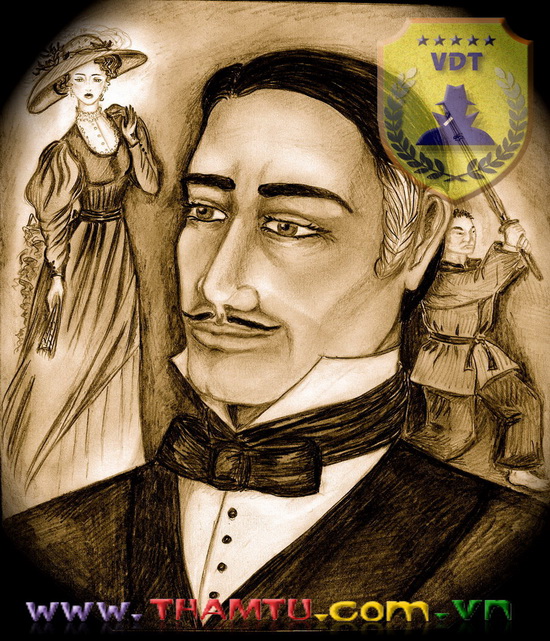Thám tử Fandorin – Tiểu thuyết trinh thám nổi tiếng của nước Nga
Erast Petrovich Fandorin (tiếng Nga: Эраст Петрович Фандорин) là một tiểu thuyết trinh thám kể về một thám tử hư cấu của Nga thế kỷ 19 và sau này tên nhân vật đã trở thành người hùng của một loạt các tiểu thuyết trinh thám của nhà văn Nga Boris Akunin.
Cuốn tiểu thuyết thám tử Fandorin đầu tiên (The Queen Winter, rus – Азазель) đã được xuất bản ở Nga vào năm 1998 và cuốn chuyện cuối cùng được xuất bản vào tháng 11 – 2012 (Thành phố Black, rus – Чёрный город) [1]. Hơn 15 triệu bản của thám tử Fandorin đã được bán kể từ tháng 5 năm 2006, [2], mặc dù số sách lậu về cuốn tiểu thuyết được in khá nhiều và các bản sao có trên các trang web nhưng loạt chuyện về thám tử Fandorin vẫn bán được hơn 200.000 bản trong tuần đầu phát hành.
Ở Nga, tiểu thuyết trinh thám Fandorin là đối thủ The Lord of the Rings hay Harry Potter[5]. Bản dịch tiếng Anh của cuốn tiểu thuyết này cũng đã được giới phê bình đánh giá cao.
Mục lục
Background
In the Soviet Union, detective novels enjoyed mass popularity. Although they were seen as a “low genre” by the communist officials, both local (such as Vayner brothers and Julian Semenov), and foreign detective novels have always been avidly coveted.[7][8]
After the collapse of the Soviet Union, many trashy detective novels were published that featured a lot of gore and sex.[9] Akunin’s wife, in common with many other Russians,[10] started to enjoy reading this genre of literature. However, she did not want to be seen reading the novels and she always wrapped them in brown paper to prevent people from seeing what she was reading.[8][11][12] This inspired Akunin to create a detective novel which nobody would be ashamed to be caught reading,[12] something between the literature of Leo Tolstoy and Fyodor Dostoevsky and the pulp of modern Russian detective novels.[13]
He set out to write a cycle about Fandorin with an exploration of every subgenre of the detective novel in mind, from spies to serial killers.[2] In addition, he wanted to address different types of human character in his books. As Akunin identified sixteen subgenres of crime novels, as well as sixteen character types, the novels in the Erast Fandorin series will ultimately number sixteen. As of December 2009, thirteen novels have been published in Russia. The series is titled Новый детективъ (New detective, or New Mystery). This title serves to set the novels apart from the postmodernist intellectual novels as well as from the trashy detective novels,[5] but it is also a subtle play on the use of time in the novels.[7]
Akunin uses many historical settings for his novels. He uses the war between Russia and the Ottoman Empire as background for the novel The Turkish Gambit; the death of the “White General” Mikhail Skobelev (as ‘Mikhail Sobolev’) in The Death of Achilles; and the coronation of Tsar Nicholas II and the Khodynka Tragedy for Coronation, or the Last of the Romanovs. Akunin uses the gaps in the knowledge of these histories to create an atmosphere for his mystery novels to which readers can relate.[5]
Personal life
Biography and career
Akunin describes in The Winter Queen how Erast Fandorin was orphaned at the age of nineteen. He never knew his mother, and his father died bankrupt, leaving only debts. Fandorin had to abandon his education at Moscow University and was forced to enter the police force as a clerk. Since the events in The Winter Queen take place in the spring of 1876 (when Akunin says Fandorin is twenty), this places his birth some time in the year 1856. Further hints at Fandorin’s ancestry are given in another novel, Altyn Tolobas, one of four novels set in the present day and featuring Fandorin’s grandson Nicholas, where Akunin writes of how Captain Cornelius von Dorn, a German hussar, entered Russia in ca. 1680. Erast Fandorin represents the 8th generation counting from Cornelius, the German name von Dorn having been Russified to Fandorin in the 18th century.
In The Winter Queen, Fandorin falls in love with a seventeen-year-old girl, Elizaveta, whom he meets while he is investigating his first case. On their wedding day, she was killed by a bomb in a package addressed to Fandorin himself. At the time of the explosion, Fandorin was out pursuing the person who delivered the bomb and thus miraculously escaped without physical harm. The trauma of losing his bride leads to a lifelong slight stammer in Fandorin and a premature greyness at the temples.
In The Turkish Gambit, Fandorin is charged with the capture of a Turkish spy during the war between Russia and the Ottoman empire. Upon his return, he requests to be stationed in a remote post, and becomes second secretary to the Russian ambassador in Japan. His adventures in Japan are detailed in the second part of The Diamond Chariot and in Jade Rosary Beads. In Japan, he saves the life of the fallen yakuza Masa, who becomes his manservant as a token of gratitude. He learns martial arts, including ninjutsu, and trains in them every day with Masa. In The Death of Achilles Akunin describes how Fandorin returns to Russia, only to find his old friend General Mikhail Sobolev murdered. Fandorin enters the service of The Governor-General of Moscow, Knyaz Dolgoruki (a fictionalized version of Vladimir Dolgorukov).
Fandorin rises from the rank of Collegiate Registrar to that of Collegiate Counsellor over the years 1876 to 1891 (ranks XIV and VI in the Table of Ranks, respectively).
In The State Counsellor, set in 1891, Fandorin is accused of the murder of the high ranking official General Khrapov. After he clears his name, Fandorin is offered the job of Oberpolizeimeister but declines, instead resigning from public service and becoming a private investigator. He then leaves for America, studying engineering at M.I.T., in 1895, as told in Jade Rosary Beads. In The Coronation, Fandorin returns to Russia in time to prevent an international scandal from occurring during the coronation of Tsar Nicholas II of Russia in 1896. In 1905, Fandorin protects the Trans-Siberian Railway from Japanese saboteurs during the Russo-Japanese War.
Allusions to the fate of Fandorin are made in Altyn Tolobas. Late in life Fandorin marries again and has at least one son, Alexander, who is born in exile in London in 1920, his mother having left Russia in 1919 while pregnant, which implies that Erast Fandorin died in that year in the turmoils of the Russian Civil War. Alexander’s son, Nicholas Fandorin, is born around 1960.
Physical appearance and other characteristics
Boris Akunin provides the reader with a vivid portrait of Erast Fandorin. Fandorin is of average height, with a thin build. He has a small moustache, blue eyes and black hair. The death of his wife caused his hair to turn grey at the temples almost overnight, as described in The Winter Queen. It also caused him to stammer, but this tends to diminish as tensions rise. Fandorin is always impeccably groomed and can be vain about his appearance; in The Winter Queen he wears a corset to improve his figure. He is a gifted linguist; in various novels he speaks English, French, German and Japanese with fluency, as well as a working knowledge of both Serbian and Turkish in The Turkish Gambit.
In every novel, Fandorin is described as a master of disguise, which he uses to infiltrate criminal hideouts and in stakeouts. When he is disguised, he does not stammer at all. In The Coronation, Fandorin explains that this is because he always takes on the personality of the disguise, which often requires that he should not stammer. In The Winter Queen, he learns to present evidence by making a list: “That is one. That is two. And that is three”. He is brave and determined, and has to kill several men during his investigative career, but he is still sickened by the sight of blood. While in Japan, he learns the art of the ninjas (or “silent ones”, as they are referred to in the novels). He is physically fit and athletic. In his later years, Fandorin becomes an enthusiast of the newly invented automobile.
Fandorin is exceptionally lucky, a common trait in the Fandorin family that skips every other generation; allusions to this character trait appear in every novel. He never loses a bet, and wins at all sports. He has however lost the appetite for gambling, as it soon became boring. He can be popular with the opposite sex, partly because he still mourns the loss of his first wife – this sadness seems to attract women.[3]
Allusions and references to other works
According to Akunin, he mixed several of the most sympathetic heroes of Russian literature to form the Erast Fandorin character.[14] One of these heroes is Chatsky from Alexander Griboyedov’s Woe from Wit, from whom Fandorin inherits his sense of duty: “To serve the cause, not the individuals”.[3] Other heroes Erast Fandorin is based upon are Andrei Bolkonski (from Leo Tolstoy’s War and Peace), Prince Myshkin (from Fyodor Dostoevsky’s The Idiot) and Pechorin (from Mikhail Lermontov’s A Hero of Our Time).[11]
Akunin said he “plots along the line of Kazuo Ishiguro’s Remains of the Day”.[15] The orphaned urchin Senka, the narrator of He Lover of Death, is clearly based upon Oliver Twist (also pointed out by the subtitle of that novel: a Dickensian story).[3] The entire first volume of The Diamond Chariot is an allusion to Alexander Kuprin’s Junior Captain Rybnikov,[7] and the opening sentence of The Winter Queen is a clear reference to Mikhail Bulgakov’s The Master and Margarita.[7] A more subtle allusion exists to Leo Tolstoy’s Anna Karenina, as the novel The Winter Queen starts with a suicide in 1876, exactly the same year in which Anna throws herself under a train.[5] Another allusion to Anna Karenina can be found in The Jack of Spades, where Fandorin’s current girlfriend, who is married to another man, has the same patronymic (Arkadievna) as Anna Karenina herself. In Murder on the Leviathan, one of the newspaper fragments is signed by G. du Roy, an allusion to the journalist Georges Duroy from Guy de Maupassant’s Bel Ami.[5]
In The Death of Achilles the hired killer Achimas is mentioned as having been secretly hired by the Italian government to kill an anarchist nicknamed “The Jackal” who plans to kill King Umberto – yet Achimas himself bears considerable similarity to the hired killer nicknamed “The Jackal” who plans to kill Charles de Gaulle in Frederick Forsyth’s “The Day of the Jackal”. Furthermore, Achimas’ lifestory mirrors that of the Iliad’s Achilles and the events described in the second part of the novel allude to Homer’s work.
Novels
| English title | Russian title | Russian original publication | English translation | Genre |
|---|---|---|---|---|
| The Winter Queen | Азазель (Azazel) | 1998 | 2003 | Conspiracy mystery |
| The Turkish Gambit | Турецкий гамбит | 1998 | 2005 | Spy novel |
| Murder on the Leviathan | Левиафан (Leviathan) | 1998 | 2004 | Agatha Christie-type mystery |
| The Death of Achilles | Смерть Ахиллеса | 1998 | 2005 | Hired killer mystery |
| Special Assignments | Особые поручения | 1999 | 2007 | Comical adventure/gory thriller |
| The State Counsellor | Статский советник | 2000 | 2009 | Political mystery |
| The Coronation | Коронация, или Последний из Романов (Coronation, or the Last of the Romanovs/novels (polysemantic)) | 2000 | 2009 | High society mystery |
| She Lover of Death | Любовница смерти (Mistress of Death) | 2001 | 2009 | Decadent mystery |
| He Lover of Death | Любовник смерти (Lover of Death) | 2001 | 2010[16] | Dickensian mystery |
| The Diamond Chariot | Алмазная колесница | 2003 | 2011[17] | Ethnographic mystery |
| Jade Rosary Beads | Нефритовые Четки | 2006 | Different for each story in collection | |
| All the World’s a Stage | Весь мир театр | 2009 | Theatrical mystery | |
| The Black city | Черный город | 2012 | Thriller, political mystery |
Akunin’s stated goal in creating the Fandorin series was to try as many approaches to detective fiction as possible.
The Winter Queen
Moscow, 1876. The 20-year-old Erast Fandorin, recently orphaned, enters civil service as a clerk in the Criminal Investigations Department of the Moscow Police. While investigating a scandalous but, seemingly, quite straightforward case of public suicide by a rich young man, Fandorin uncovers a powerful and terrible conspiracy.
The Turkish Gambit
Pleven, 1877. During the Russo-Turkish war of 1877, an encrypted message is mysteriously altered, leading to strategic gains by the Turks. Fandorin, an agent of the Third Section (Russia’s secret police), is ordered to find the Turkish spy before more damage to the Russian cause is done.
Murder on the Leviathan
Red Sea, 1878. A terrible mass murder is committed in Paris and clues lead “Papa” Gauche, a French police inspector on board the British steamship Leviathan, sailing from Southampton to Calcutta. Fandorin, now a diplomat newly appointed to a post in Japan, is one of the passengers. Will Gauche’s experience and Fandorin’s talents be enough to uncover the killer?
The Death of Achilles
Moscow, 1882. After four years of diplomatic service in Japan, Fandorin returns to Moscow with his Japanese manservant Masa. He arrives just in time to hear about the premature death of war hero Mikhail Sobolev, who apparently suffered heart failure in his hotel room. Fandorin, who has just assumed the post of the Governor-General’s Deputy for Special Assignments, is very suspicious of the circumstances of Sobolev’s death. Before long, his investigation will lead him to another quite extraordinary man.
Special Assignments
Special Assignments (Russian: Особые поручения) is a single volume containing two different novellas, The Jack of Spades (Russian: Пиковый валет) and The Decorator (Russian: Декоратор). They both deal with Fandorin’s service as the Deputy for Special Assignments (hence the name) for the Moscow Governor-General Prince Dolgorukoi. In “The Jack of Spades”, set in 1886 Moscow, Fandorin and his assistant Tulipov pursue a crafty con man who has successfully tricked the Governor-General himself. In “The Decorator”, set in 1889 Moscow, Fandorin and Tulipov chase a serial killer who might be Jack the Ripper himself.
The State Counsellor
Moscow, 1891. Disguised as Fandorin, the leader of a revolutionary Combat Group murders a reactionary general. The attack having occurred in Moscow Province, Prince Dolgorukoi’s career is put into grave danger. After Fandorin is cleared, he attempts to pursue the Combat Group and its leader Mr. Green, an extremely tough and resourceful man. Police official Prince Pozharsky, dispatched from St. Petersburg, takes over the case and proves to be quite a talented man in his own right. Pushed aside, Fandorin must find a way to rescue his boss’ reputation.
The Coronation
Moscow, May 1896. The imperial family moves to Moscow for the coronation of Tsar Nicholas II. However, Nicholas’ 4-year-old cousin Mikhail is abducted and the kidnapper demands a diamond from the royal sceptre as ransom. The absence of the diamond in the sceptre would create an international scandal. The kidnappers are a world-famous gang headed by mysterious international supercriminal Dr. Lind. Erast Fandorin, now a private detective, has been tracking Lind from America to Russia and is ready to offer his assistance to the royal family.
She Lover of Death
Moscow, 1900. Fandorin deals with a suicide club. The action takes place contemporaneously with the events of He Lover of Death. It is told from the point of view of “Columbine”, a Moscow debutante from Irkutsk, whose attraction to decadent literature and a sentimental nature may prove to be fatal. The theme of the novel is an allusion to Robert Louis Stevenson’s short-story cycle The Suicide Club.
He Lover of Death
Moscow, 1900. The action takes place contemporaneously with the events of She Lover of Death. It is told from the point of view of Senka, a boy from the Khitrovka slums, who has gotten himself mixed up in very dangerous criminal activity. Fandorin and Masa, in Moscow investigating the suicide club, offer their assistance to the reluctant Senka.
The Diamond Chariot
This novel consists of two parts. In the first part, set during the Russo-Japanese War of 1905, Fandorin, in charge of protecting the Trans-Siberian Railway from sabotage, is tracking down a Japanese agent. In the second part, set in 1878, Fandorin’s arrival in Yokohama and his adventures there are recounted. Upon entering diplomatic service, he is immediately mixed up into a political assassination plot and crosses a clan of ninjas. In a way that does not become apparent until the end, this story is related to the first part of the novel.
The title Алмазная Колесница (“Diamond Vehicle”) refers to the Kongōjō school of Tantric Buddhism. The first part is structured as a haiku, with each chapter taking the place of a syllable, while the second part is meant to serve as a “meaning between the lines” of the haiku.
The Black city
This is the last novel about the adventures of Erast Fandorin, which takes place in the city of Baku (center of the Oil industry in the Russian Empire), before the First World War. His enemy is one of the main leaders of the Revolutionary movement, who is in charge of financing the “Party”.
Jade Rosary Beads
Jade Rosary Beads (Russian: Нефритовые четки) about Fandorin’s adventures in the 19th century was issued in Russia on 21 November 2006. The book contains three novellas and seven short stories, some of which take Fandorin abroad to England, America, and France. It is illustrated by Igor Sakurov.[18]
Each short story and novella is dedicated to a different author and includes allusions to that author’s works. The plots of the short stories in this volume are as follows:
- Shigumo (Сигумо). Set in Yokohama in 1881, during Fandorin’s diplomatic service in Japan. A private investigation of a former colleague’s death leads Fandorin to explore Japanese mysticism. The story serves as a “postscriptum” to The Diamond Chariot. Dedicated to Sanyutei Encho.
- Table-Talk, 1882 (Table-Talk 1882 года). Shortly after the event described in The Death of Achilles Fandorin is invited to a high-society gathering where he is presented with a six-year-old unsolved mystery of a disappearance of a rich land-owner’s daughter. On a bet, Fandorin agrees to solve the case without leaving the room. Dedicated to Edgar Allan Poe.
- From the Lives of Woodchips (Из жизни щепок). One year into his new job as a Deputy for Special Assignments, Fandorin is asked to investigate the poisoning of a Russian railroad tycoon. He undertakes the investigation by going undercover as a clerk in the victim’s company. Dedicated to Georges Simenon, as Fandorin uses a “psychological method” similar to that of Simenon’s Maigret.
- Jade Rosary Beads (Нефритовые четки). The year is 1884 and Fandorin is looking into the brutal murder of an antiques salesman who, among other things, sold Oriental souvenirs. The story deals with Chinese culture and is dedicated to Robert van Gulik.
- The Scarpea of the Baskakovs (Скарпея Баскаковых). In the fall of 1888 Fandorin sends his personal assistant Tulipov to a village outside of Moscow, where the populace is disturbed by an alleged appearance of a giant snake. According to a legend, such a snake is to bring the end to the local noble family and Fandorin suspects foul play. The story is dedicated to Arthur Conan Doyle and contains many parallels to Conan Doyle’s novel The Hound of the Baskervilles.
- One Tenth Percent (Одна десятая процента). This story takes place in 1890 as Fandorin is investigating an apparent murder, but is baffled by the suspect’s complete lack of motives. Dedicated to Patricia Highsmith.
- Tea in Bristol (Чаепитие в Бристоле). Shortly after the events described in The State Councillor Fandorin finds himself in England, mulling over his future and renting a room from a kindly old lady, Miss Palmer. The ex-detective grows fond of the sharp-minded spinster and together they decide to unravel the curious disappearance of Lord Berkley. The dedication is to Agatha Christie, while Miss Palmer is an homage to (and an anagram of) Christie’s character of Miss Marple.
The short stories are followed by three novellas.
- Dream Valley (Долина Мечты). The year is 1894 and Fandorin is living in America, studying engineering at MIT. But his fame as a detective follows him there and soon he is off to Wyoming to help a local bigwig out of a difficult situation. This piece is written in the genre of a Western and is dedicated to Washington Irving.
- Before the End of the World (Перед концом света). Set in 1897, this story follows Fandorin to the Russian North, where he is observing the first census of the Russian Empire. The local Old Believers are opposed to the government’s initiative and somebody is stirring them up. Fandorin, naturally, gets involved into this religious-themed mystery, dedicated to Umberto Eco.
- The Prisoner of the Tower, or A Short But Beautiful Journey of Three Wise Men (Узница башни, или Краткий, но прекрасный путь трех мудрых). Set at the dawn of the new century (31 December 1899), this story is dedicated to Maurice Leblanc and his short story Herlock Sholmes Arrives Too Late. In a stately château in northern France, a local noble is terrorized by the famed extortionist Arsène Lupin. In desperation, the noble sends for both Sherlock Holmes and Erast Fandorin to help him out of the seemingly impossible situation. The story is told from two points of view, those of Holmes’ companion Dr. John Watson and Masa, Fandorin’s Japanese manservant.
All the World’s a Stage
Moscow, 1911. Somebody is menacing the leading actress of the “Noah’s Ark Theatre” Eliza Altairskaya-Lointaine. At first she discovers a viper in her flowers. Then all men, who love her, either die or get killed. The 55-year-old Fandorin tries to investigate this mystery and help Eliza, but falls in love himself. In order to gain Eliza’s heart he writes a play for the “Noah’s Ark Theatre”, in which Eliza has the leading part. Will Fandorin be able to set his mind on the villain, or will he be completely captured by the object of his affection?
Stage
Ying and Yan is an original play featuring Fandorin. Subtitled A theatrical experiment, it features both a “white version” and a “black version”. When a wealthy man dies, Fandorin is brought in to clarify some points of the will. After the murder of several characters, Fandorin (assisted by his manservant Masa) needs his sleuthing skills once more. The black version leads to a diametrically opposed result to that of the white version, due to some minor changes in evidence found in the beginning of the play. This play is notable for the comic element introduced by Masa’s limited knowledge of Russian—he has begun copying out words from the dictionary but so far has gotten only to the letter “D”. The play was commissioned by director Aleksey Borodin.
Typography
Akunin uses typography to enhance the story that is being told. Newspaper stories are typeset in a different font (see The Turkish Gambit). He even goes so far that chapters written from the perspective of a Japanese (see Leviathan) are rotated ninety degrees to give the illusion of traditional Japanese writing. (This effect is omitted in the American edition of Leviathan.)
Translations
Novels from the Erast Fandorin series have been translated into more than 30 languages.[5] Because Akunin saw the English-language market as key to the rest of the world, he was very cautious when selecting the person who was allowed to translate the Fandorin novels into English, eventually choosing Andrew Bromfield.[2] As of 2011 all the Fandorin novels through The Diamond Chariot have been translated into English. Random House, the American publisher, published only the first four novels.[9] The British publisher is Weidenfeld & Nicolson, a division of Orion Publishing. The fate of future novels is uncertain; Orion Publishing is referring to The Diamond Chariot as the “finale” to the series.[19]
Each of the first three translated novels have sold over 50,000 copies in the UK alone.[20] The Winter Queen has been described as the possible result if Aleksandr Pushkin had written mystery novels, and Andrew Bromfield was lauded as one of England’s finest translators from Russian.[12] Critics were also very favorable about Murder on the Leviathan, but less so about The Turkish Gambit, which offers a far slower pace than The Winter Queen.[21] The Death of Achilles has again been received very positively.[22][23]
The first ten novels have been translated into German, with the eleventh due in October 2006. Dutch publisher De Geus has completed its announced translations of the first seven novels.[24] Translations for the other novels have not yet been announced. In Italian and French, the first 8 novels have been translated. The first eight novels have been translated in Norwegian. The whole cycle has been translated into Polish by Jerzy Czech and have been published successively since 2003 by Świat Książki (World of Books) Publishing. All the novels have been translated into Bulgarian. The first seven novels has been translated into Hebrew between 2004 and 2011.
Adaptations
Azazel was filmed for television in 2003 by Alexander Adabashyan, and has also been adapted for the stage in Russia.[25] Reviews of the play have not been very favorable and have called it long, windy, talky and situational,[25] or entertaining but plodding.[26]
In 2005, two further Fandorin novels, The Turkish Gambit and The Councillor of State, were made into big-budget movies by Dzhanik Faiziyev and Filip Yankovsky respectively. The adaptation of The Turkish Gambit set a new box office record in Russia of 19.23 million USD,[27] beating The Lord of the Rings: The Return of the King by more than 5 million USD.[28] It was met by criticism from the Russian military, who said the film stains the memory of general Mikhail Skobelev.[29] The Turkish Gambit won three Golden Eagle Awards (best art design, best costume design and best film editing), while The Councillor of State won two awards (best leading actor for Nikita Mikhalkov and best supporting actor for Konstantin Khabensky).[30]
Ying and Yan has also been performed on stage in Russia, with both versions performed back-to-back on two consecutive days. They met with critical acclaim.[26] Prior to September 2006, all Erast Fandorin films, plays and television programs have been made in Russian only.
The Winter Queen has also been adapted as a graphic novel by Aleksey Kuzmichev.
Paul Verhoeven owns the rights to a future English-language film version of The Winter Queen.[31] Filming was scheduled to start in July 2007, with Milla Jovovich as the female lead actress,[32][33][34] but was postponed due to Jovovich’s pregnancy.[35] The film has been rescheduled for 2010, with Jovovich, Anton Yelchin cast as Erast Fandorin, and Russian director Fyodor Bondarchuk replacing Verhoeven, who is producing.[36]
Awards
- The Crime Writers’ Association of Britain nominated Akunin for the 2003 Dagger Awards for The Winter Queen, a translation of the novel Azazel.[37]
- Murder on the Leviathan was nominated for Best European Crime Novel in the Gumshoe Awards 2005.[38]
- Coronation, or the Last of the Romanovs won the Russian Anti-Booker 2000 in the category Brothers Karamazov.[10]


















